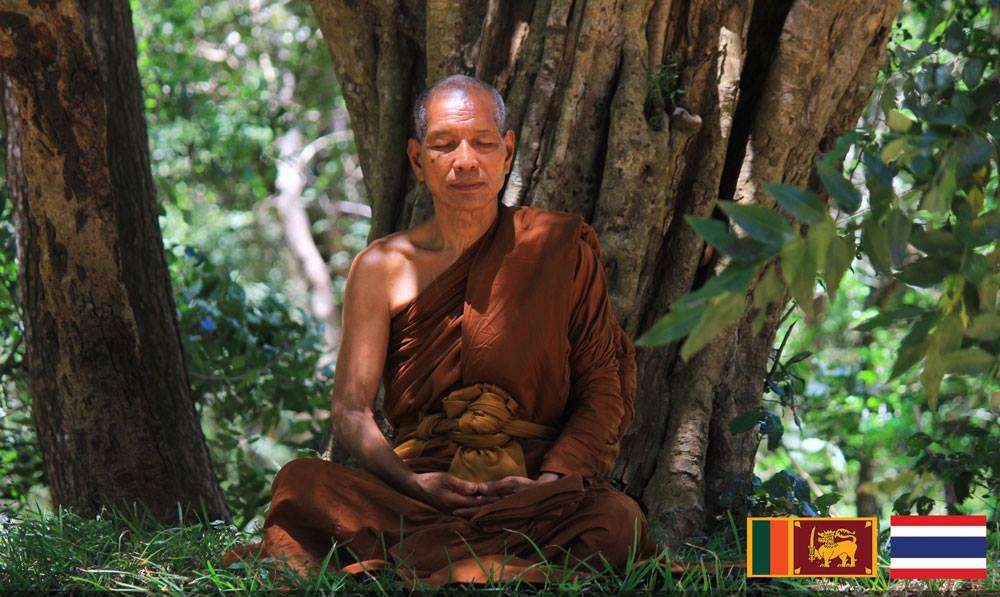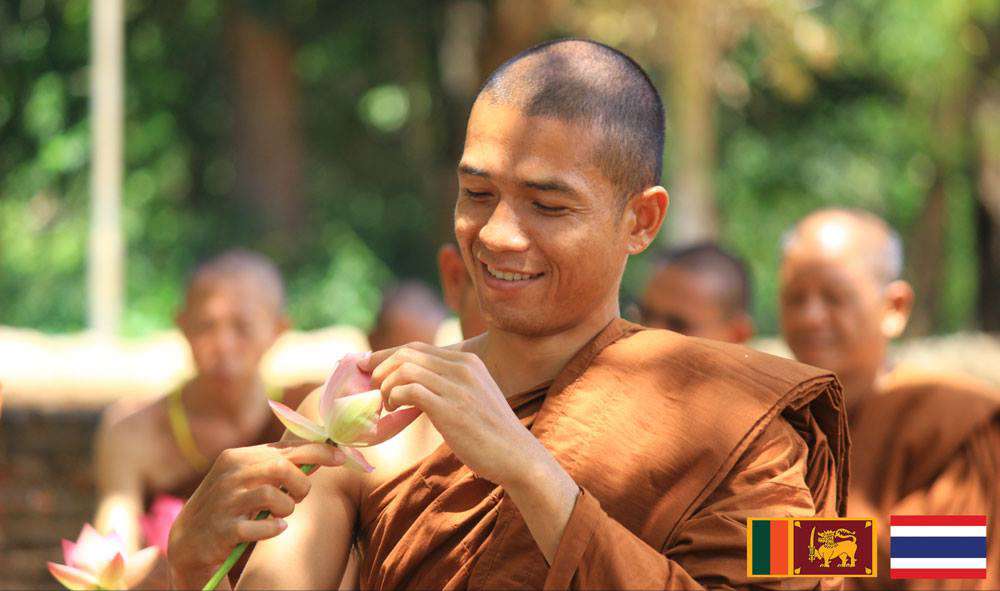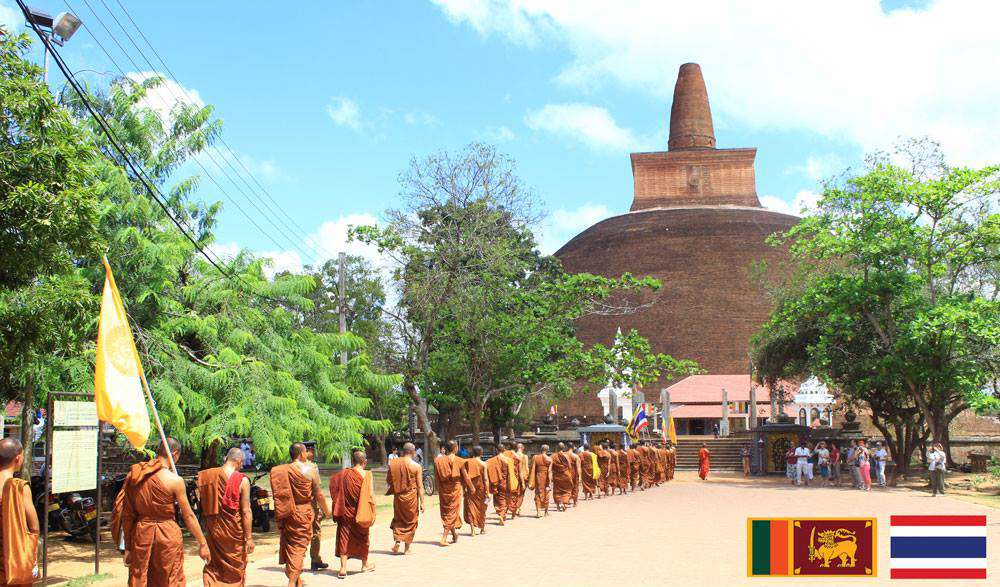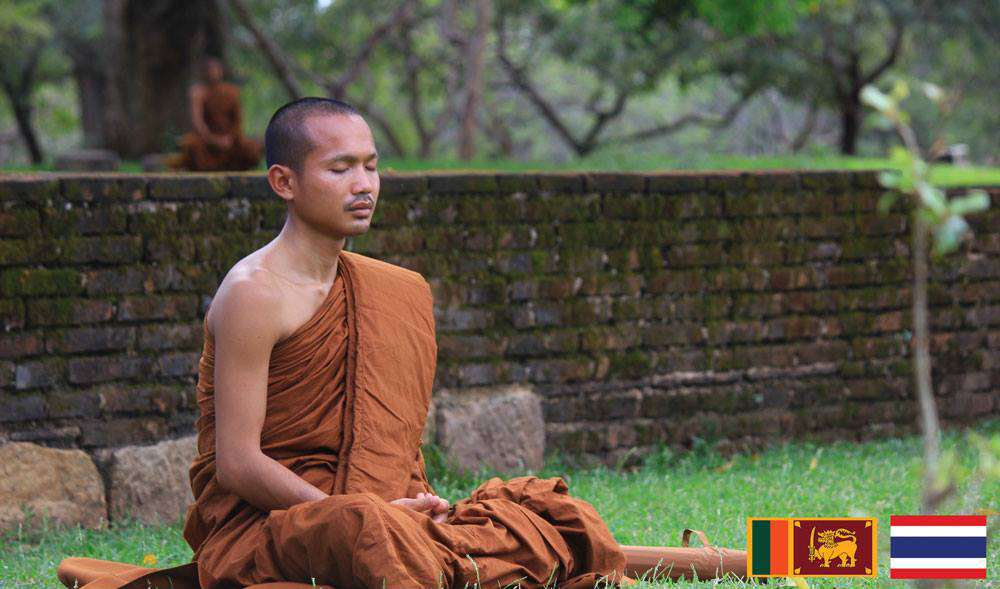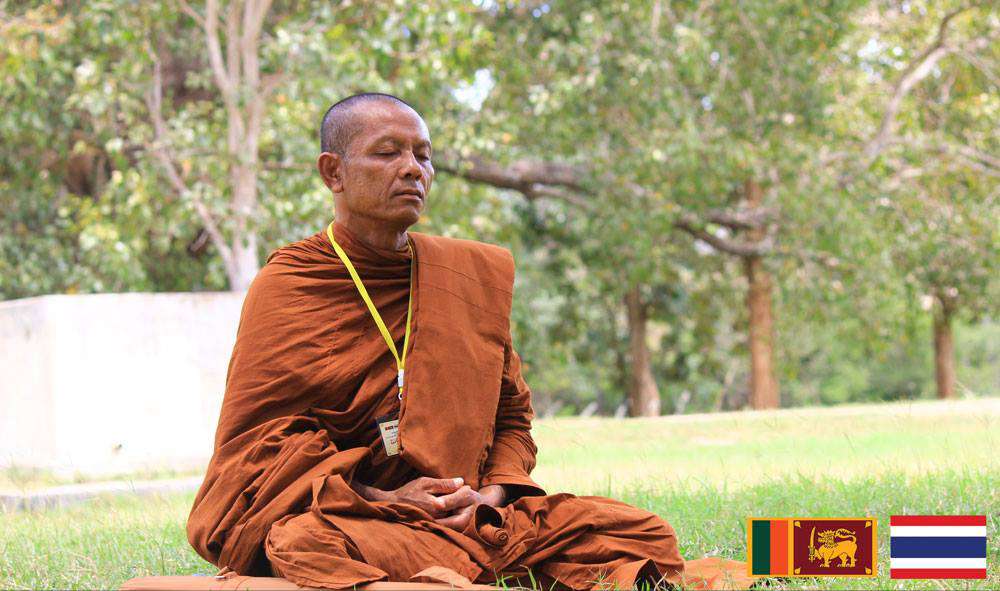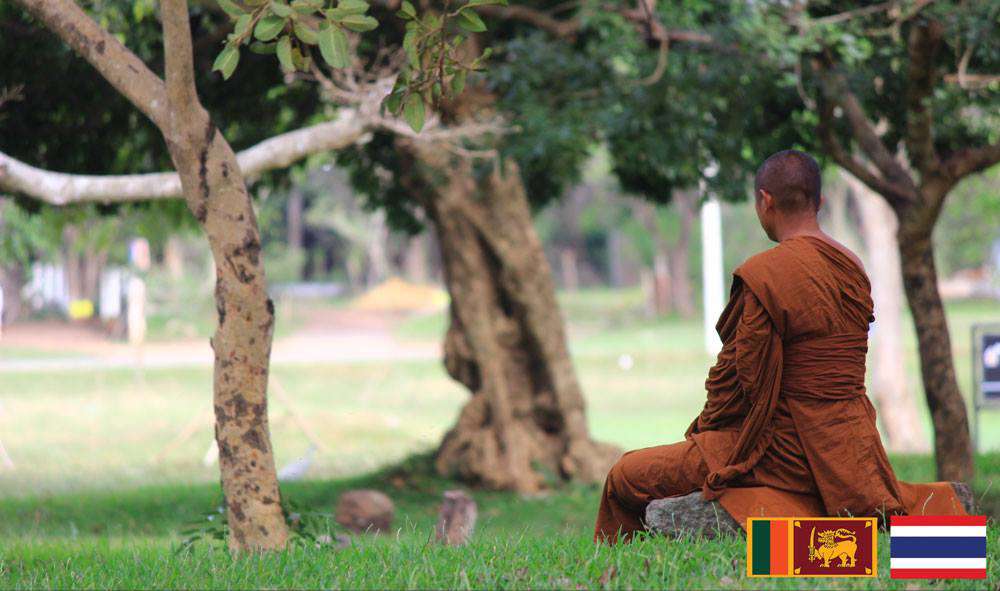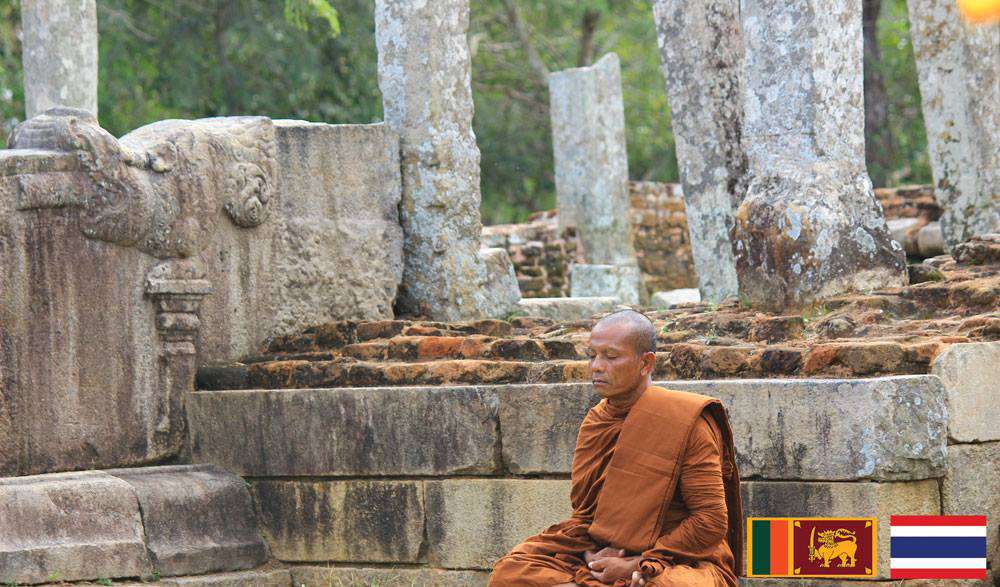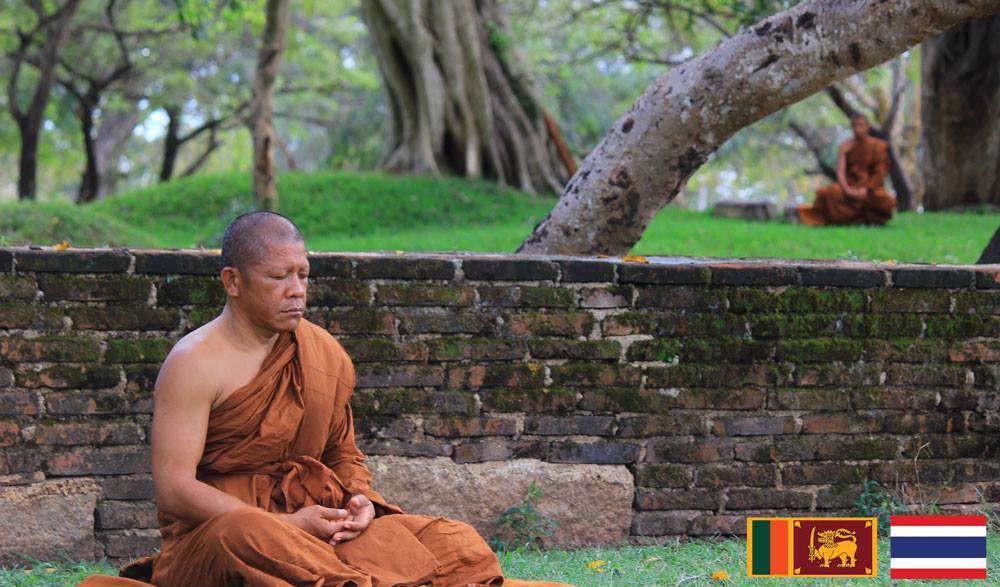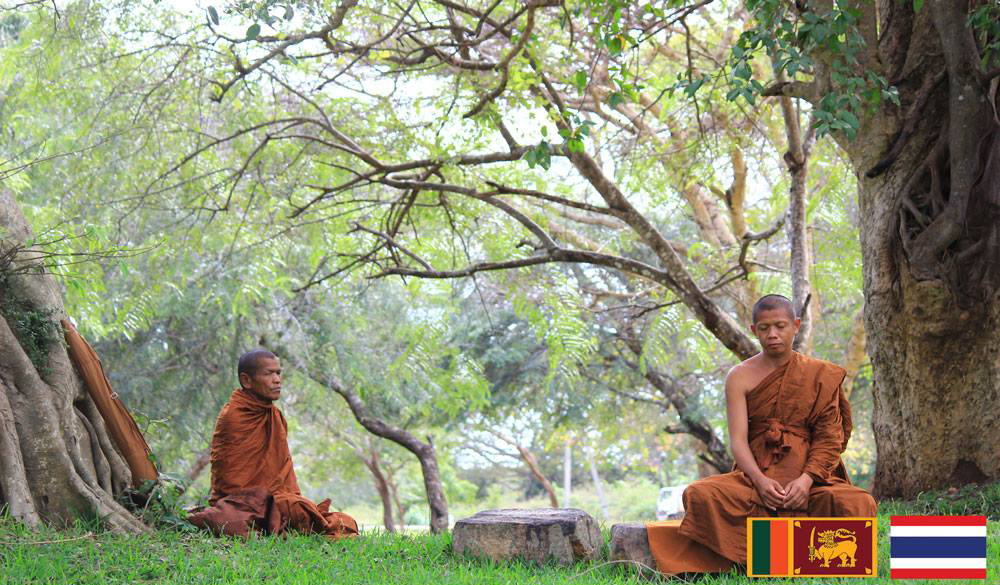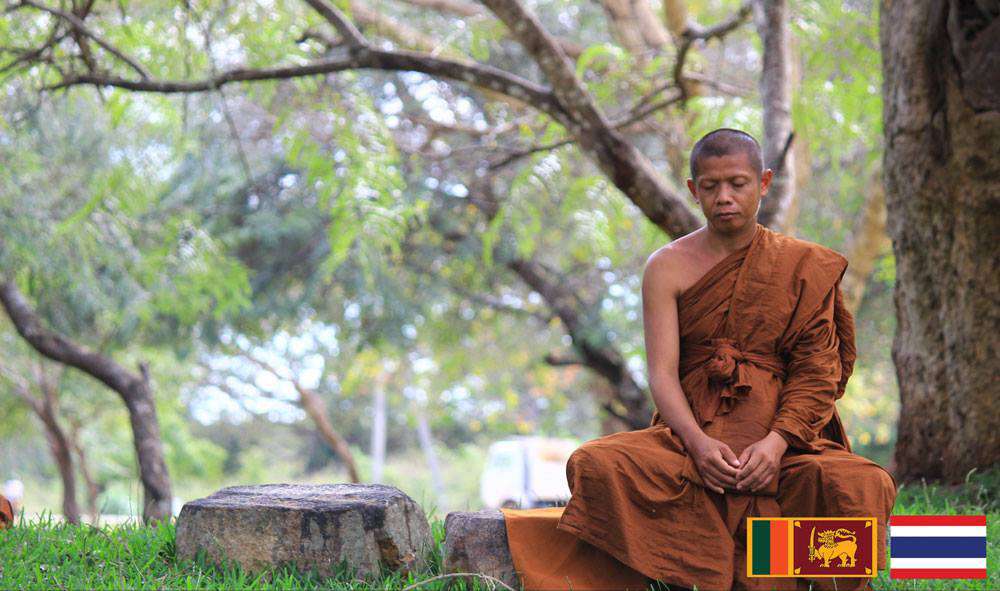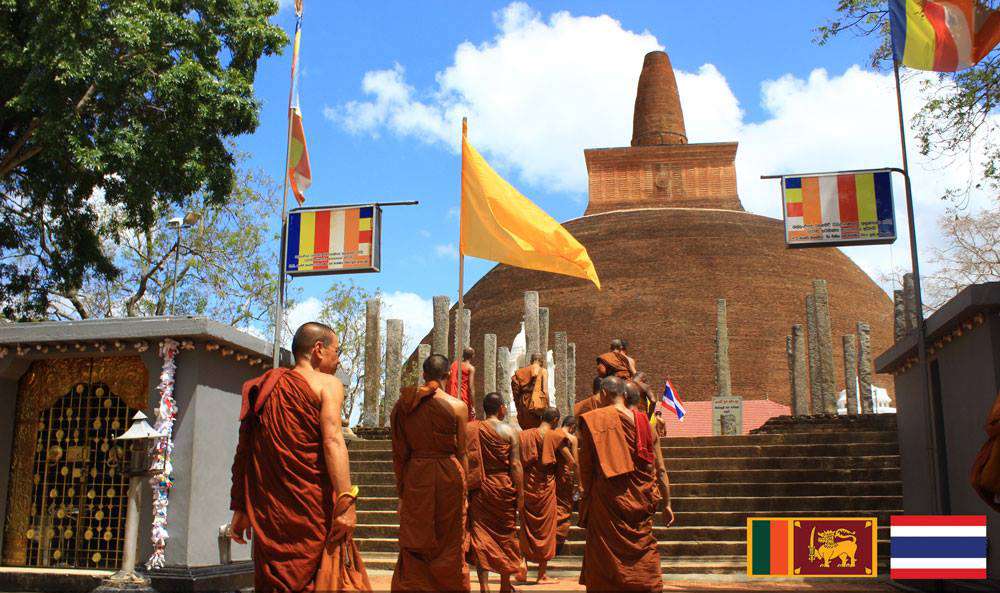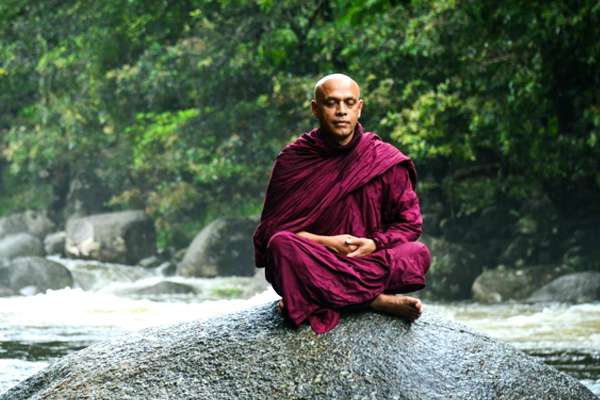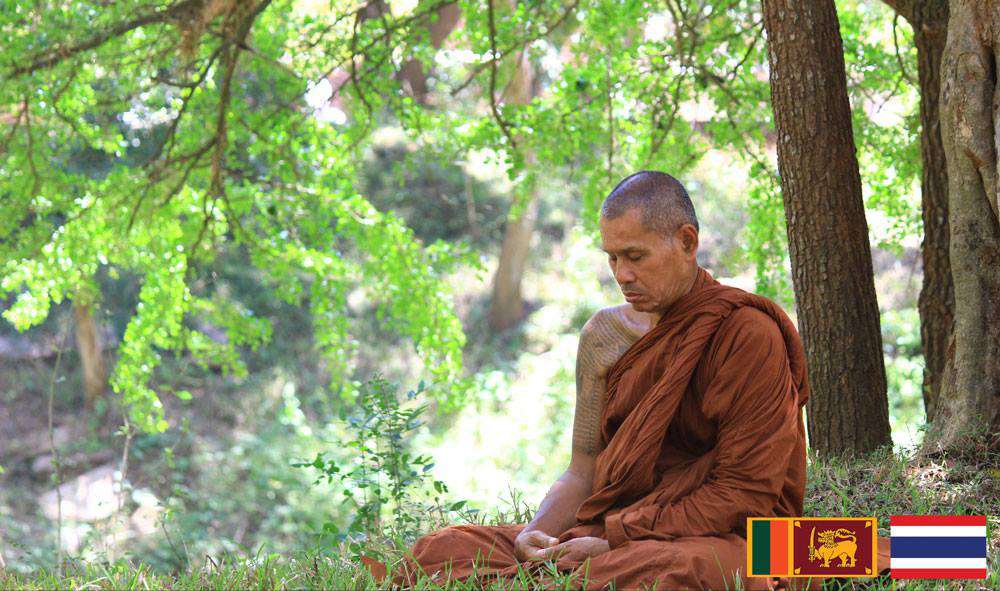1.6 Navasīvathika Pabbaṁ: Nine Charnel-Ground Contemplations
1.6.1 Paṭhamaṁ Sīvathikaṁ: First Charnel-Ground Comtemplations
Puna ca paraṁ bhikkhave bhikkhu / seyyathāpi passeyya sarīraṁ sīvathikāya chaḍḍitaṁ / ekāhamataṁ vā dvīhamataṁ vā tīhamataṁ vā / uddhumātakaṁ, vinīlakaṁ, vipubbakajātaṁ./ So imameva kāyaṁ upasaṁharati./ Ayampi kho kāyo evaṁ dhammo, evaṁ bhāvī, etaṁ anatīto’ti./
“Again, monks, as though a monk were to see a corpse • thrown aside in a charnel ground, • one, two, or three days dead, • bloated, blue, and festering, • a monk compares this very body with it thus: • ‘This body is of the same nature, • it will be like that, • it is not exempt from that fate.’
Iti ajjhattaṁ vā kāye kāyānupassī viharati./ Bahiddhā vā kāye kāyānupassī viharati./ Ajjhatta bahiddhā vā kāye kāyānupassī viharati./
“In this way he dwells contemplating his own body, • he dwells contemplating others’ bodies, • and he dwells contemplating both his and others’ bodies.
Samudaya dhammānupassī vā kāyasmiṁ viharati./ Vaya dhammānupassī vā kāyasmiṁ viharati./ Samudaya vaya dhammānupassī vā kāyasmiṁ viharati./
“He dwells contemplating the arising of the body, • he dwells contemplating on the passing away of the body, • and he dwells contemplating the arising and passing away of the body.
Atthi kāyo’ti vā panassa sati paccupaṭṭhitā hoti./ Yāvadeva ñāṇa mattāya, patissati mattāya,/ anissito ca viharati./ Na ca kiñci loke upādiyati./
“Mindfulness, that there is a body • is simply established in him • to the extent necessary for higher knowledge and mindfulness. He dwells independent, and not clinging to anything in the world.
Evampi kho bhikkhave bhikkhu / kāye kāyānupassī viharati./
That is how monks, a monk dwells contemplating the body in body.
1.6.2 Dutiyaṁ Sīvathīkaṁ: Second Charnel-Ground Contemplation
Puna ca paraṁ bhikkhave, bhikkhu / seyyathāpi passeyya sarīraṁ sivathikāya chaḍḍītaṁ,/ kākehi vā khajjamānaṁ, kulalehi vā khajjamānaṁ,/ gijjhehi vā khajjamānaṁ, sunakhehi vā khajjamānaṁ,/ sigālehi vā khajjamānaṁ, vividhehi vā pāṇaka jātehi khajjamānaṁ,/ so imameva kāyaṁ upasaṁharati./ Ayampi kho kāyo evaṁ dhammo, evaṁ bhāvī, etaṁ anatītoti./
“Again monks, as though a monk were to see a corpse thrown aside in a charnel ground, • being devoured by crows, hawks, vultures, dogs, jackals, • or various kinds of creatures, • he compares this very body with it thus: • ‘This body is of the same nature, • it will be like that, • it is not exempt from that fate.’
Iti ajjhattaṁ vā kāye kāyānupassī viharati./ Bahiddhā vā kāye kāyānupassī viharati./ Ajjhatta bahiddhā vā kāye kāyānupassī viharati./
“In this way he dwells contemplating his own body, • he dwells contemplating others’ bodies, • and he dwells contemplating both his and others’ bodies.
Samudaya dhammānupassī vā kāyasmiṁ viharati./ Vaya dhammānupassī vā kāyasmiṁ viharati./ Samudaya vaya dhammānupassī vā kāyasmiṁ viharati./
“He dwells contemplating the arising of the body, • he dwells contemplating the passing away of the body, • and he dwells contemplating the arising and passing away of the body.
Atthi kāyo’ti vā panassa sati paccupaṭṭhitā hoti./ Yāvadeva ñāṇa mattāya, patissati mattāya,/ anissito ca viharati./ Na ca kiñci loke upādiyati./
“Mindfulness, that there is a body • is simply established in him • to the extent necessary for higher knowledge and mindfulness. He dwells independent, and not clinging to anything in the world.
Evampi kho bhikkhave bhikkhu / kāye kāyānupassī viharati./
That is how monks, a monk dwells contemplating the body in body.
1.6.3 Tatiyaṁ Sīvathīkaṁ: Third Charnel-Ground Contemplation
Puna ca paraṁ bhikkhave, bhikkhu / seyyathāpi passeyya sarīraṁ sīvatikāya chaḍḍitaṁ,/ aṭṭhisaṅkhalikaṁ, samaṁsalohitaṁ, nahārusambaddhaṁ./ So imameva kāyaṁ upasaṁharati./ Ayampi kho kāyo evaṁ dhammo, evaṁ bhāvī, etaṁ anatīto’ti./
“Again monks, as though a monk were to see a corpse • thrown aside in a charnel ground, • a skeleton with flesh and blood, • held together with blood vessels; • he compares this very body with it thus: • ‘This body is of the same nature, • it will be like that, • it is not exempt from that fate.’
Iti ajjhattaṁ vā kāye kāyānupassī viharati./ Bahiddhā vā kāye kāyānupassī viharati./ Ajjhatta bahiddhā vā kāye kāyānupassī viharati./
“In this way he dwells contemplating his own body, • he dwells contemplating others’ bodies, • and he dwells contemplating both his and others’ bodies.
Samudaya dhammānupassī vā kāyasmiṁ viharati./ Vaya dhammānupassī vā kāyasmiṁ viharati./ Samudaya vaya dhammānupassī vā kāyasmiṁ viharati./
“He dwells contemplating the arising of the body, • he dwells contemplating the passing away of the body, • and he dwells contemplating the arising and passing away of the body.
Atthi kāyo’ti vā panassa sati paccupaṭṭhitā hoti./ Yāvadeva ñāṇa mattāya, patissati mattāya,/ anissito ca viharati./ Na ca kiñci loke upādiyati./
“Mindfulness, that there is a body • is simply established in him • to the extent necessary for higher knowledge and mindfulness. He dwells independent, and not clinging to anything in the world.
Evampi kho bhikkhave bhikkhu / kāye kāyānupassī viharati./
That is how monks, a monk dwells contemplating the body in body.
1.6.4 Catutthaṁ Sīvathīkaṁ: Fourth Charnel-Ground Contemplation
Puna ca paraṁ bhikkhave, bhikkhu / seyyathāpi passeyya sarīraṁ sīvathikāya chaḍḍītaṁ,/ aṭṭhi saṅkhalikaṁ, nimmaṁsa lohitamakkhitaṁ, nahāru sambaddhaṁ./ So imameva kāyaṁ upasaṁharati./ Ayampi kho kāyo evaṁ dhammo, evaṁ bhāvī, etaṁ anatīto’ti./
“Again monks, as though a monk were to see a corpse • thrown aside in a charnel ground, • a fleshless skeleton smeared with blood, • held together with blood vessels, • he compares this very body with it thus: • ‘This body is of the same nature, • it will be like that, • it is not exempt from that fate.’
Iti ajjhattaṁ vā kāye kāyānupassī viharati./ Bahiddhā vā kāye kāyānupassī viharati./ Ajjhatta bahiddhā vā kāye kāyānupassī viharati./
“In this way he dwells contemplating his own body, • he dwells contemplating others’ bodies, • and he dwells contemplating both his and others’ bodies.
Samudaya dhammānupassī vā kāyasmiṁ viharati./ Vaya dhammānupassī vā kāyasmiṁ viharati./ Samudaya vaya dhammānupassī vā kāyasmiṁ viharati./
“He dwells contemplating the arising of the body, • he dwells contemplating the passing away of the body, • and he dwells contemplating the arising and passing away of the body.
Atthi kāyo’ti vā panassa sati paccupaṭṭhitā hoti./ Yāvadeva ñāṇa mattāya, patissati mattāya,/ anissito ca viharati./ Na ca kiñci loke upādiyati./
“Mindfulness, that there is a body • is simply established in him • to the extent necessary for higher knowledge and mindfulness. He dwells independent, and not clinging to anything in the world.
Evampi kho bhikkhave bhikkhu / kāye kāyānupassī viharati./
That is how monks, a monk dwells contemplating the body in body.
1.6.5 Pañcamaṁ Sīvathīkaṁ: Fifth Charnel-Ground Contemplation
Puna ca paraṁ bhikkhave, bhikkhu / seyyathāpi passeyya sarīraṁ sīvathikāya chaḍḍitaṁ,/ aṭṭhika saṅkhalikaṁ, apagata maṁsalohitaṁ nahāru sambaddhaṁ./ So imameva kāyaṁ upasaṁharati./ Ayampi kho kāyo evaṁ dhammo, evaṁ bhāvī, etaṁ anatīto’ti./
“Again monks, as though a monk were to see a corpse • thrown aside in a charnel ground, • a skeleton without flesh and blood, • held together with blood vessels; • he compares this very body with it thus: • ‘This body is of the same nature, • it will be like that, • it is not exempt from that fate.’
Iti ajjhattaṁ vā kāye kāyānupassī viharati./ Bahiddhā vā kāye kāyānupassī viharati./ Ajjhatta bahiddhā vā kāye kāyānupassī viharati./
“In this way he dwells contemplating his own body, • he dwells contemplating others’ bodies, • and he dwells contemplating both his and others’ bodies.
Samudaya dhammānupassī vā kāyasmiṁ viharati./ Vaya dhammānupassī vā kāyasmiṁ viharati./ Samudaya vaya dhammānupassī vā kāyasmiṁ viharati./
“He dwells contemplating the arising of the body, • he dwells contemplating the passing away of the body, • and he dwells contemplating the arising and passing away of the body.
Atthi kāyo’ti vā panassa sati paccupaṭṭhitā hoti./ Yāvadeva ñāṇa mattāya, patissati mattāya,/ anissito ca viharati./ Na ca kiñci loke upādiyati./
“Mindfulness, that there is a body • is simply established in him • to the extent necessary for higher knowledge and mindfulness. He dwells independent, and not clinging to anything in the world.
Evampi kho bhikkhave bhikkhu / kāye kāyānupassī viharati./
That is how monks, a monk dwells contemplating the body in body.
1.6.6 Chaṭṭhaṁ Sīvathīkaṁ: Sixth Charnel-Ground Contemplation
Puna ca paraṁ bhikkhave, bhikkhu / seyyathāpi passeyya sarīraṁ sīvathikāya chaḍḍitaṁ / aṭṭhikāni apagatasambandhāni / disāvidisāsu vikkhittāni / aññena hatthaṭṭhikaṁ, aññena pādaṭṭhikaṁ,/ aññena jaṅghaṭṭhikaṁ, aññena ūraṭṭhikaṁ,/ aññena piṭṭhiṭṭhikaṁ, aññena kaṭaṭṭhikaṁ,/ aññena gīvaṭṭhikaṁ, aññena dantaṭṭhikaṁ,/ aññena sīsakaṭāhaṁ./ So imameva kāyaṁ upasaṁharati./ Ayampi kho kāyo evaṁ dhammo, evaṁ bhāvī, etaṁ anatīto’ti./
“Again monks, as though a monk were to see a corpse • thrown aside in a charnel ground, • disconnected bones scattered in all directions: • here a hand-bone, there a foot-bone, • here a shin-bone, there a thigh-bone, • here a hip-bone, there a back bone, • here a rib-bone, there a pelvis, • here a neck-bone, there the teeth and here the skull. He compares this body with it thus: • ‘This body is of the same nature, • it will be like that, • it is not exempt from that fate.’
Iti ajjhattaṁ vā kāye kāyānupassī viharati./ Bahiddhā vā kāye kāyānupassī viharati./ Ajjhatta bahiddhā vā kāye kāyānupassī viharati./
“In this way he dwells contemplating his own body, • he dwells contemplating others’ bodies, • and he dwells contemplating both his and others’ bodies.
Samudaya dhammānupassī vā kāyasmiṁ viharati./ Vaya dhammānupassī vā kāyasmiṁ viharati./ Samudaya vaya dhammānupassī vā kāyasmiṁ viharati./
“He dwells contemplating the arising of the body, • he dwells contemplating the passing away of the body, • and he dwells contemplating the arising and passing away of the body.
Atthi kāyo’ti vā panassa sati paccupaṭṭhitā hoti./ Yāvadeva ñāṇa mattāya, patissati mattāya,/ anissito ca viharati./ Na ca kiñci loke upādiyati./
“Mindfulness, that there is a body • is simply established in him • to the extent necessary for higher knowledge and mindfulness. He dwells independent, and not clinging to anything in the world.
Evampi kho bhikkhave bhikkhu / kāye kāyānupassī viharati./
That is how monks, a monk dwells contemplating the body in body.
1.6.7 Sattamaṁ Sīvathīkaṁ: Seventh Charnel-Ground Contemplation
Puna ca paraṁ bhikkhave, bhikkhu / seyyathāpi passeyya sarīraṁ sīvathīkāya chaḍḍitaṁ / aṭṭhikāni setāni saṅkhavaṇṇupanibhāni./ So imameva kāyaṁ upasaṁharati./ Ayampi kho kāyo evaṁ dhammo, evaṁ bhāvī, etaṁ anatīto’ti./
“Again monks, as though a monk were to see a corpse • thrown aside in a charnel ground, • bones bleached white, the colour of shells, • he compares this very body with it thus: • ‘This body is of the same nature, • it will be like that, • it is not exempt from that fate.’
Iti ajjhattaṁ vā kāye kāyānupassī viharati./ Bahiddhā vā kāye kāyānupassī viharati./ Ajjhatta bahiddhā vā kāye kāyānupassī viharati./
“In this way he dwells contemplating his own body, • he dwells contemplating others’ bodies, • and he dwells contemplating both his and others’ bodies.
Samudaya dhammānupassī vā kāyasmiṁ viharati./ Vaya dhammānupassī vā kāyasmiṁ viharati./ Samudaya vaya dhammānupassī vā kāyasmiṁ viharati./
“He dwells contemplating the arising of the body, • he dwells contemplating the passing away of the body, • and he dwells contemplating the arising and passing away of the body.
Atthi kāyo’ti vā panassa sati paccupaṭṭhitā hoti./ Yāvadeva ñāṇa mattāya, patissati mattāya,/ anissito ca viharati./ Na ca kiñci loke upādiyati./
“Mindfulness, that there is a body • is simply established in him • to the extent necessary for higher knowledge and mindfulness. He dwells independent, and not clinging to anything in the world.
Evampi kho bhikkhave bhikkhu / kāye kāyānupassī viharati./
That is how monks, a monk dwells contemplating the body in body
1.6.8 Aṭṭhamaṁ Sīvathīkaṁ: Eighth Charnel-Ground Contemplation
Puna ca paraṁ bhikkhave, bhikkhu / seyyathāpi passeyya sarīraṁ sīvathikāya chaḍḍitaṁ,/ aṭṭhikāni puñjīkatāni terovassikāni./ So imameva kāyaṁ upasaṁharati./ Ayampi kho kāyo evaṁ dhammo, evaṁ bhāvī, etaṁ anatīto’ti./
“Again monks, as though a monk were to see a corpse • thrown aside in a charnel ground, • bones heaped up, several years old, • he compares this very body with it thus: • ‘This body is of the same nature, • it will be like that, • it is not exempt from that fate.’
Iti ajjhattaṁ vā kāye kāyānupassī viharati./ Bahiddhā vā kāye kāyānupassī viharati./ Ajjhatta bahiddhā vā kāye kāyānupassī viharati./
“In this way he dwells contemplating on his own body, • he dwells contemplating others’ bodies, • and he dwells contemplating both his and others’ bodies.
Samudaya dhammānupassī vā kāyasmiṁ viharati./ Vaya dhammānupassī vā kāyasmiṁ viharati./ Samudaya vaya dhammānupassī vā kāyasmiṁ viharati./
“He dwells contemplating the arising of the body, • he dwells contemplating the passing away of the body, • and he dwells contemplating the arising and passing away of the body.
Atthi kāyo’ti vā panassa sati paccupaṭṭhitā hoti./ Yāvadeva ñāṇa mattāya, patissati mattāya,/ anissito ca viharati./ Na ca kiñci loke upādiyati./
“Mindfulness, that there is a body • is simply established in him • to the extent necessary for higher knowledge and mindfulness. He dwells independent, and not clinging to anything in the world.
Evampi kho bhikkhave bhikkhu / kāye kāyānupassī viharati./
That is how monks, a monk dwells contemplating the body in body.
1.6.9 Navamaṁ Sīvathīkaṁ: Ninth Charnel-Ground Contemplation
Puna ca paraṁ bhikkhave, bhikkhu / seyyathāpi passeyya sarīraṁ sīvathikāya chaḍḍitaṁ,/ aṭṭhikāni pūtīni, cuṇṇaka jātāni./ So imameva kāyaṁ upasaṁharati./ Ayampi kho kāyo evaṁ dhammo, evaṁ bhāvī, etaṁ anatīto’ti./
“Again monks, as though a monk were to see a corpse • thrown aside in a charnel ground, • bones rotted away to dust like lime powder, • he compares this very body with it thus: • ‘This body is of the same nature, • it will be like that, • it is not exempt from that fate.’
Iti ajjhattaṁ vā kāye kāyānupassī viharati./ Bahiddhā vā kāye kāyānupassī viharati./ Ajjhatta bahiddhā vā kāye kāyānupassī viharati./
“In this way he dwells contemplating his own body, • he dwells contemplating others’ bodies, • and he dwells contemplating both his and others’ bodies.
Samudaya dhammānupassī vā kāyasmiṁ viharati./ Vaya dhammānupassī vā kāyasmiṁ viharati./ Samudaya vaya dhammānupassī vā kāyasmiṁ viharati./
“He dwells contemplating the arising of the body, • he dwells contemplating the passing away of the body, • and he dwells contemplating the arising and passing away of the body.
Atthi kāyo’ti vā panassa sati paccupaṭṭhitā hoti./ Yāvadeva ñāṇa mattāya, patissati mattāya,/ anissito ca viharati./ Na ca kiñci loke upādiyati./
“Mindfulness, that there is a body • is simply established in him • to the extent necessary for higher knowledge and mindfulness. He dwells independent, and not clinging to anything in the world.
Evampi kho bhikkhave bhikkhu / kāye kāyānupassī viharati./
That is how monks, a monk dwells contemplating the body in body.
(The section on contemplating the body in body is finished.)


